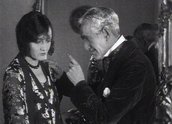


The Cheaters (sound version) (1931)
Synopsis
Bill Marsh (Arthur Greenaway) serves a 20-year prison sentence for embezzling from businessman John Travers (John Faulkner). On his release Marsh forms a criminal organisation whose members include his daughter Paula Marsh (Isabel McDonagh billed as 'Marie Lorraine’), and whose activities include stealing from Travers’ jewellery store. When Marsh sends Paula to rob wealthy guests at a country hotel, she meets and falls in love with Travers’ adopted son, Lee (Josef Bambach). Having developed a conscience about her life of crime, Paula considers herself undeserving of Lee and is determined to disappear from his life.
Marsh asks Paula to conduct one final theft, but unknown to her the target is again John Travers. As Paula tries breaking into Travers’ safe, Lee and his father confront her, and she is sent to prison. Appalled at this turn of events, Marsh confesses to John Travers that Paula is Travers’ daughter, stolen as a baby by Marsh’s agents. Just as police break into his hideaway, Marsh suicides. Travers arranges for Paula’s release, clearing the way for Paula and Lee to marry.
Curator’s notes
The ‘full talkie’ (complete sound) version of The Cheaters is the most mysterious film among the handful of features and shorts produced by Isabel, Paulette and Phyllis McDonagh between 1926 and 1933. Where the McDonagh sisters’ first two features, Those Who Love (1926) and The Far Paradise (1928), enjoyed saturation publicity, no less than three versions of The Cheaters – a silent of 1929, a part-talkie of 1930, and a full talkie that was completed in 1931 – had almost none. The McDonaghs and their backer Neville Macken made no mention of the full talkie (to be known from this point on as the sound version) when interviewed by historians and journalists in the 1970s, and one has to look hard for passing references to it in newspapers and film trade magazines of the 1930s.
On 23 November 1930 the Sydney Sun said the McDonaghs would make Two Minutes Silence (released in 1933) 'after they have finished revising and doing some of the talkie portions of their film The Cheaters'. On 15 October 1931 Martin C Brennan reported in Film Weekly that Charles Hardy of Celebrity Pictures was distributing a ’synchronised’ version of The Cheaters, and the result was ’an efficient talkie’. But by 4 February 1934, Paulette McDonagh in an interview for the Sydney Sun said that by the time the sound version was complete, it was ’hopelessly out of date … By that time, Dame Fashion was lowering her dresses and raising an ironical eyebrow at brevity in skirts!’
To go by the absence of published advertisements, the sound version of The Cheaters may never have been publicly screened. Fade-out to two remarkable coincidences 50 years later, when the film’s key creators had been dead for some years. In 1988 the NFSA announced that the first reel of this previously unknown version had been discovered in a laneway by a Bondi (Sydney) resident, Mr T Davey. In 1990 Ruth Hill of the NFSA’s Nitrate Preservation Program (established 1988) found three more reels while inspecting previously unidentified films acquired from film collector Ron Noad. Altogether the talkie Cheaters’ surviving sequences totalled 35 minutes out of an original duration of 81 minutes. But this is enough footage to give today’s viewer a vivid sense of what the original sound version was like, showing also the budget constraints of its making.
Standardtone, the sound-on-film recording process used in this version, was, like The Cheaters itself, funded by former grazier Neville Macken. In backing the McDonaghs’ cameraman Jack Fletcher to invent and perfect this process, Macken originally intended that the McDonaghs would use it to create a part-talkie version of The Cheaters in time for the 31 March 1930 deadline of the federal government’s competition for best Australian film. Nevertheless Standardtone was still too primitive to be used for the part-talkie version, and the McDonaghs produced that version using sound-on-disc equipment at the Melbourne-based Vocalion Records. By January 1931 Standardtone was sufficiently developed for Macken to establish Standardtone Sound Recording Studios Ltd and to use his sound-on-film process to record Norman Dawn’s film Showgirl’s Luck (1931), in which Macken also invested. Macken and the McDonagh sisters next used Standardtone for the full talkie conversion of The Cheaters.
The conversion from silent to full sound film involved meticulously shooting selected new close-ups with synchronised sound, and dubbing the remainder of the silent version with dialogue, effects and music. But if a bigger budget had allowed them to, the McDonaghs would have been better advised to reshoot the entire Cheaters with synchronised sound, its dialogue rewritten for sound rather than silent filmmaking. As it is, the surviving result is an endearing curio, an experiment that jolts sporadically to authentic life as a sound film should, with Isabel McDonagh’s warm, subtle voice adding dimension to her character. But elsewhere what had been a coherent silent is compromised by imprecise synchronisation and patches of dialogue more like spoken titles than exchanges between believable sound film characters. The film also suffers from the conventions of silent screen performance being turned on their head by the realism that sound cinema could demand.
The scenes that benefit from sound include Bill Marsh’s farewell to Paula before her trip to a hotel, Paula’s preparation for her first evening at the hotel, and a dining room scene where ambient conversation and music increases the tension of Paula setting eyes on a rope of pearls she is supposed to steal before she takes her first sustained look at her soon-to-be boyfriend, Lee Travers. The sound version also contains scenes not present in the surviving silent Cheaters, some of them evidently shot mute and added to the sound version, others apparently belonging to the silent in the first place.
- Overview
- Curator’s notes
- Video 3 clips
- Principal credits
- Find a copy
- Comments 1
- Map
- Add your review



